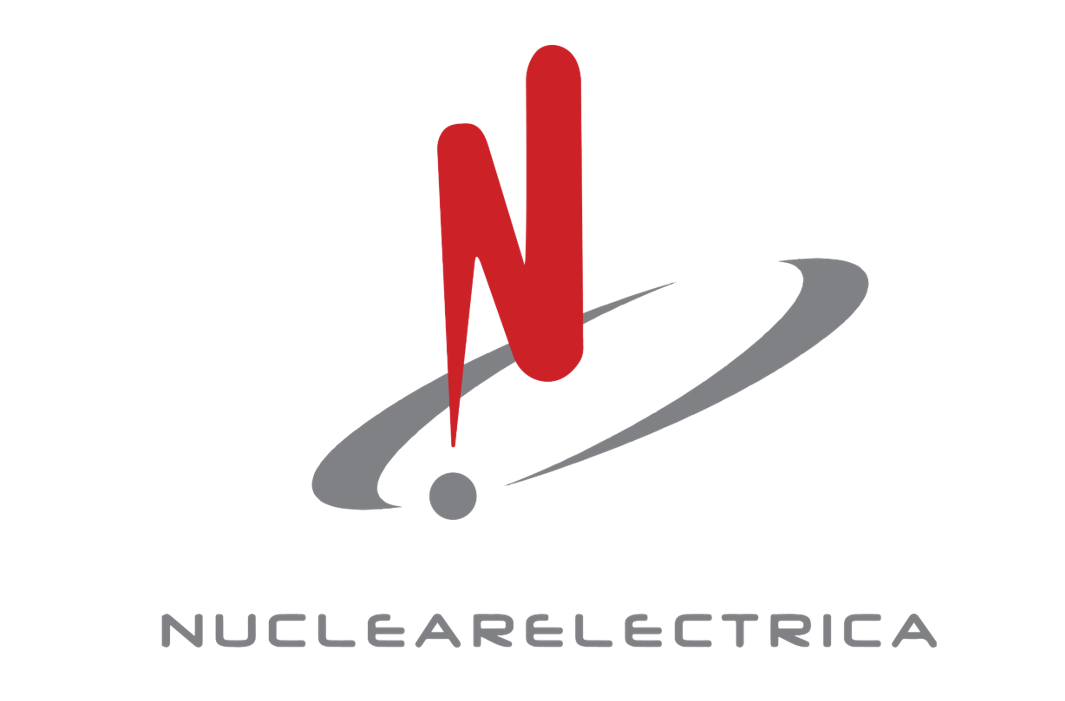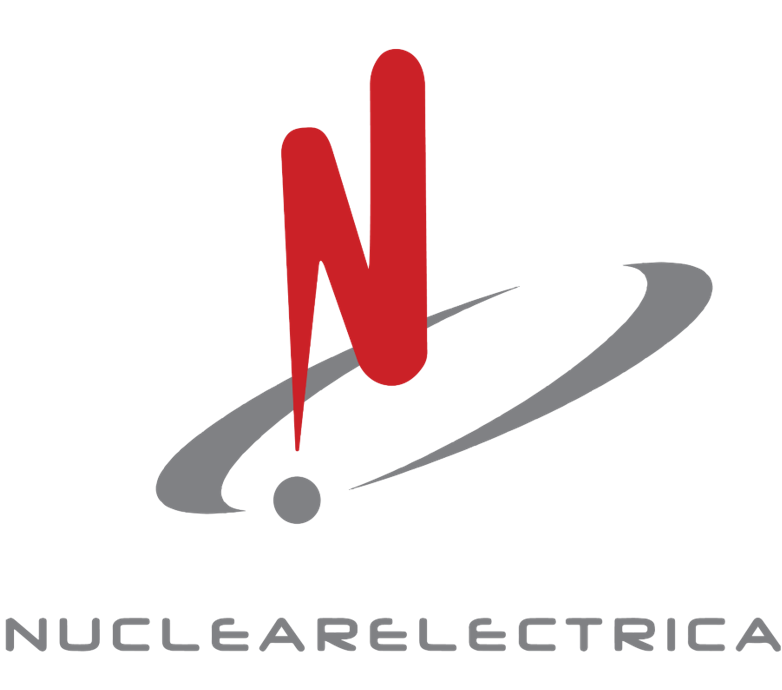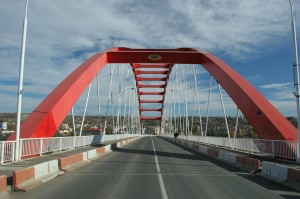- History
- Organizational structure
- International cooperation
- The relationship with the local community
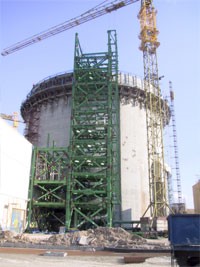 1976 – Completion of the Romanian-Canadian feasibility study for the CANDU system in Romania
1976 – Completion of the Romanian-Canadian feasibility study for the CANDU system in Romania
April 14, 1979 – Beginning of the first land development works on the CNE Cernavoda site
May 11, 1979 – Entry into force of the contracts between ROMENERGO and AECL (Atomic Energy of Canada Ltd) for the acquisition of the CANDU system license, the design and procurement of equipment specific to the nuclear part of Unit 1
September 1980 – Casting of the first blade at the subradiator of the reactor building 1
February 1981 – Conclusion of the ROMENERGO – ANSALDO (Italy) and General Electric (USA) contracts for the classic part of Unit 1
Trim. IV 1981 – The first excavation works for the foundations of Unit 2 buildings
1982 – Pouring of the first concrete for the Unit 1 reactor building
March 16, 1983 – Sliding of the perimeter wall at the reactor building 1
November 1983 – Sliding of the perimeter wall at the reactor 2 building
December 1985 – Arrival of the Calandria vessel for Unit 1
August 1988 – Installation of reactor 1 feeder assembly
December 1989 – The investment stage of Unit 1 is 45%
February 1990 – The Government approves the construction of the Cernavoda NPP with 5 units
April-May 1993 – The first PREOSART mission at the Cernavoda NPP of the International Atomic Energy Agency (IAEA) in Vienna
August 1991 – Conclusion of the contract between RENEL and the AECL-ANSALDO Consortium for the completion, commissioning and initial operation of Unit 1, CNE Cernavoda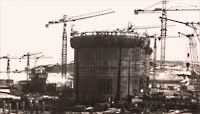
August 1992 – Entry into force of the contract with the AECL-ANSALDO Consortium
1993 – Stoppage of works for Unit 2
January 31, 1995 – Start of filling the moderator with heavy water – Unit 1 reactor
May 15, 1995 – Issuance of CNCAN authorization for PIF
June 10, 1995 – Start of manual loading with nuclear fuel – Unit 1 reactor
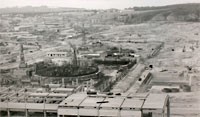 April 16, 1996 – The first criticality of the Unit 1 reactor
April 16, 1996 – The first criticality of the Unit 1 reactor
July 11, 1996 – First connection of Unit 1 to the National Energy System
October 2, 1996 – Reaching the nominal power of Unit 1
December 2, 1996 – Transition to commercial operation of Unit 1
June 30, 1997 – Transfer of exploitation responsibility from the AECL-ANSALDO Consortium to RENEL – FCNE Cernavoda
February 5, 1999 – Completion of commissioning of the Full Scope Simulator
April 28, 1999 – Obtaining the first authorization for the operation of Unit 1 from CNCAN, with prior obtaining of the environmental authorization by HG # 234/99
August 31, 1999 – Final reception – Unit 1
May 21, 2001 – Signing of the completion and commissioning contract with AECL and ANSALDO
March 24, 2003 – Entry into force of the contract for completion and commissioning with AECL and ANSALDO
September 5, 2006 – Filling the moderator with heavy water – Unit 2 reactor
February 15, 2007 – The introduction of the first nuclear fuel beam into the active zone of the Unit 2 reactor at CNE Cernavoda
February 22, 2007 – Completion of reactor loading with nuclear fuel – Unit 2 became a nuclear target
March 2, 2007 – Loading heavy water into the cooling circuit of the Unit 2 reactor
May 7, 2007 – The first criticality of Unit 2’s reactor
August 7, 2007 – Connection to the national distribution network of Unit 2
September 12, 2007 – Reaching the nominal power of Unit 2
September 28, 2007 – Transition to commercial operation and handing over the management of Unit 2 to SN Nuclearelectrica – CNE Cernavoda
October 5, 2007 – Official inauguration of Unit 2
November 2007 – Obtaining the first authorization to operate Unit 2 from CNCAN
December 14, 2009 – The final reception of Unit 2
April 29, 2010 – Obtaining the reauthorization of operation and maintenance of Unit 1 and Unit 2, from CNCAN.
December 16, 2010 – Obtaining the ISO 27001 certification – “Information Security Management System – CNE Cernavoda”.
October 28, 2011 – Preparation of the “Report on the Reassessment of Nuclear Safety Margins at Cernavoda NPP” and submission to CNCAN
February 7, 2012 – Establishment of the Community Information and Consultation Council (CICC)
12 – 15 martie 2012 – European Nuclear Safety Regulators Group (ENSREG) – Stress Test Peer Review Board
November 16, 2012 – Annual Radiological Emergency Exercise “BRUMAR 2012”
October 14 ÷ November 1, 2013 – WANO Peer Review Mission
November 29, 2013 – Annual Radiological Emergency Exercise “SATURN 2013”
September 19, 2014 – Annual Radiological Emergency Exercise “WEDNESDAY 2014”
March 16 – 17, 2015 – Signing at CNE Cernavodă of the collaboration protocol between CANDU 6, CANDU Owners Group and CANDU Energy Inc.
October 13, 2015 – Annual Radiological Emergency Exercise “AXIOPOLIS 2015”
02 – 20 November 2015 – WANO Peer Review Mission
October 4-6, 2016 – Annual Radiological Emergency Exercise “VALAHIA 2016”
November 6-26, 2016 – OSART Mission (Operational Safety Review Team)
November 27, 2017 – Annual Radiological Emergency Exercise “TOMIS 2017”
June 11, 2018 – Annual Radiological Emergency Exercise “UNIREA 2018”
29 October – 16 November 2018 – WANO Peer Review Mission
4 – 8 March 2019 – OSART Mission (IAEA) Follow-up
October 23, 2019 – Annual Radiological Emergency Exercise “EUROPE 2019”
February 10 – 19, 2020 – PRE-SALTO mission
April 16, 2020 – Annual Radiological Emergency Exercise “SCYNTHIA 2020”
September 21, 2021 – Annual Radiological Emergency Exercise “AXIOPOLIS 2021”
25 October – 10 November 2021 – WANO Peer Review Mission
The component of the National Society “Nuclearelectrica” SA, the CNE Cernavoda branch has a functional organizational structure, centered on its main functions: production, technical, planning and control of works, nuclear security, radioprotection, economic and resources human, also including organizational components specific to some functions associated with the main ones: quality assurance, information technology, physical protection, etc.
The complexity of the processes and activities carried out requires a clear definition of responsibilities and a rigorous control of the manner of their fulfillment.
For these reasons, the organizational structure of CNE Cernavoda, specific to the nuclear industry, includes a relatively high number of hierarchical levels, compared to the existing situation in units from other fields of activity.
Within this structure, during the development of some projects, project teams with a multi-departmental component work, a fact that promotes teamwork, brings technical and economic advantages for the organization and offers development opportunities for the personnel involved.
It should be mentioned that the organizational structure is not static, this being the object of an optimization program aimed at adapting the organizational framework to the specific requirements of the successive stages of the life of the plant, increasing the organization’s ability to respond to external stimuli and influencing factors, maintaining a climate conducive to performance.
Thus, in the relatively short period since the commercial operation of the first unit of the plant (2 Dec 1996), respectively since the establishment of the National Society “Nuclearelectrica” SA (July 1998), the organizational structure of the CNE Cernavoda branch has evolved from a specific for the stage of making the investment and putting it into operation, towards an organizational formula aligned with the requirements of the exploitation stage (initially with a single operational unit, and from the second part of 2007 with 2 operational units), which is close to the models used in other organizations that operate nuclear power plants.
The process was not simple, it involved actions to analyze the activities and processes in the plant, to evaluate the local market of services and to identify the support activities that can be ensured (at quality standards and economic efficiency acceptable for the nuclear industry) by contracting services and, finally, going through several stages of internal reorganization within the departments/departments and at the branch level.
The results of these analysis, evaluation and reorganization actions are reflected, mainly, in the reduction of the weight of support activities in the unit’s object of activity, the increase in the efficiency of the managerial act by focusing it on the basic activities and processes in the plant and the economic efficiency, as a result of the significant improvement of the physical productivity indicator (from 2.3 man/MWe in 1999 to 1.1 man/MWe in 2015) and the provision of additional financial resources to motivate the employees involved in the plant’s exploitation process.
It is not without importance that these results were obtained without side effects in terms of security in the operation of the plant and without the appearance of any tensions in terms of labor relations.
The development strategy of CNE Cernavoda envisages the continuation of the optimization process of the organizational structure and personnel, the objectives associated with this direction of action for the following years being defined, in relation to the general mission of Societati Nationale Nuclearelectrica SA in the continuation of the nuclear program in Cernavoda.
Organizational chart of the CNE Cernavoda Branch
International Atomic Energy Agency (IAEA)
The International Atomic Energy Agency (IAEA) serves as the world’s intergovernmental forum for scientific and technical cooperation in the nuclear field. The IAEA encourages the use of atomic energy by the signatory states, offering them the necessary technical assistance and providing them with experts in the field, respectively the necessary logistical base. At the same time, the IAEA supervises that atomic energy is used for peaceful and not military purposes. As a specialized agency of the United Nations system, the IAEA has its headquarters at the International Center in Vienna – Austria.
Atomic Energy Company of Canada (AECL)
The Atomic Energy Company of Canada (AECL) is a major supplier of nuclear power reactors. AECL sells CANDU power reactors, MAPLE research reactors and MACSTOR spent fuel storage system. AECL carries out research and development activities in a wide field and offers services and nuclear products to customers from all over the world.
Ansaldo Energy
Ansaldo Energia is one of the important players on the business market in the field of electricity production, providing a wide range of products and services. Ansaldo Energia is headquartered in Genoa and is part of the advanced technology group Finmeccanica, jointly owned by private investors, the Government and Italian banks. It is the largest producer of thermal power plants in Italy. The company’s performance in the field is realized through a capacity of over 156,000 MW in 89 countries. It has completed more than 1700 projects from all over the world, offering a wide range of solutions. The company has been present in Romania for over 23 years.
Ansaldo Energia was involved in the construction and commissioning of Unit 1 of CNE Cernavoda and is currently also involved in the completion of Unit 2.
Ontario Electric Company (OPG)
The Ontario Electricity Company (OPG) is an Ontario company whose main business is the production and sale of electricity to customers in Ontario and interconnected markets.
FORATOM
FORATOM is the trade association of the European nuclear industry that promotes the peaceful use of nuclear energy, acting as the industry’s spokesperson in policy discussions with the European Institutions. FORATOM works to strengthen relations between industry and European institutions, especially the European Parliament and the European Commission, and has an important role in communicating with the public.
European Nuclear Society (ENS)
The objective of the European Nuclear Society is to promote and contribute to the development of science and technology in the field of the peaceful use of nuclear energy by all possible means.
World Nuclear Association
The World Nuclear Association is a global non-governmental and non-profit trade organization that focuses on nuclear power generation and all aspects of the nuclear fuel cycle, including mining, conversion, enrichment, fuel fabrication, plant construction, transportation and safe final storage of spent fuel.
Women in Nuclear (WIN)
WIN is a worldwide association of women working in the field of nuclear energy. It is led by a President and a Board of Directors. The objective of WIN is to contribute to the objective information of the public on nuclear energy.
WIN is a global organization that supports and encourages women working in the nuclear industry. It is led by a President and a Board of Directors. It currently has 2,500 members in 68 countries. The objective of WIN is to contribute to the objective information of the public on nuclear energy.
Agency for Nuclear Energy
The Nuclear Energy Agency (NEA) is a specialized agency within the Organization for Economic Cooperation and Development (OECD), an intergovernmental organization of industrialized countries based in Paris, France.
US Nuclear Regulatory Commission
The Nuclear Regulatory Commission (NRC) is an independent agency established by the Energy Reorganization Act of 1974 to regulate and control the civilian use of nuclear materials. The mission of the NRC is to regulate the national use of by-products, sources and special nuclear materials, in order to ensure the appropriate protection of the health and safety of the public, the assurance of protection and security and the protection of the environment.
Canadian Nuclear Safety Commission
The Canadian Nuclear Safety Commission (CNSC) can best be described as the watchdog for the use of nuclear energy and nuclear materials in Canada. In addition to nuclear power plants and nuclear research facilities, CNCS controls numerous other users of nuclear materials. As an example, we mention the use of radioisotopes in the treatment of cancer, the exploitation of uranium mines and refineries, the use of radioactive sources for oil exploration and in instruments such as those for measuring precipitation. The CNSC is an independent agency of the Government of Canada and operates in a transparent manner. Its operation is open to public scrutiny.
World Association of Nuclear Operators
The World Association of Nuclear Operators (WANO) is an association of all the owners of nuclear power plants in the world. It facilitates the exchange of information in the field of nuclear power plant operation experience, in this way WANO members work together to achieve the highest standards in the field of nuclear power plant operation under conditions of high nuclear safety and reliability. Through WANO, all owners of nuclear power plants can communicate and exchange information among themselves in an open and cooperative manner. This way of working allows each WANO member to benefit and learn from the experience of the other members, to align with the best global practices in the field, all with the ultimate goal of increasing the degree of security in the operation of the nuclear power plants they own.
CANDU System Owners Group (COG)
The CANDU System Owners Group is a private, non-profit corporation.
Currently COG includes 5 groups from Canada and 6 groups from Argentina, China, India, Korea, Pakistan and Romania. COG activity is generally grouped based on a program of regulation, research, maintenance, development, technical assistance, exchange of information between members.
THE SOCIAL PROGRAM
By HG 454 of June 27, 1991, regarding the improvement of social and living conditions in Cernavoda, the “Emergency Social Program for the improvement of living conditions for Cernavoda and for the construction and operating personnel of the plant” was implemented.
The works mentioned in the normative act are carried out as complementary works to the “Centrala Nuclearoelectrica Cernavoda 5 x 700 MWh” project and are transferred, without payment, to the beneficiary mentioned in the normative act.
The list of works from HG 454/1991 was changed and replaced by the list attached to HG 1.081/11.09.2003. The annex includes building, social and cultural objectives for the city of Cernavoda, as well as the housing complex for the operating staff of CNE Cernavoda.
At the end of 2008, 11 important works were completed and put to use by the beneficiary, the local community. Currently, a work is in progress.
Completed and received works:
1.1 Grocery store on the site of the plant
1.2 Kindergarten
1.3 Potable water station (pumping and treatment)
1.4 Modernization of intersections and streets
1.5 Heating networks
1.6 “Sfanta Maria” bridge for car access to the Cernavoda train station and the Fetesti-Cernavoda highway, over the Danube-Black Sea Canal
1.7 Energetic High School from Cernavoda
1.8 Hospital with 100 beds and polyclinic dispensary in Cernavoda
1.9 Sewage and residual water treatment station
1.10 Four fountains of drinking water
1.11 Housing complex
Under construction:
1.1 Training and recreation center for youth and children in the city of Cernavoda. Until now, the site has been prepared for the start of construction works.
SOCIAL EFFECTS OF CNE CERNAVODA FOR THE LOCAL COMMUNITY
- Currently providing more than 1600 jobs;
- Ensuring the heating of the city of Cernavoda, approximately 60% of the inhabitants of the city of Cernavoda, at the lowest rate in the country (30 lei/ Gcal);
- Providing accommodation for approximately 367 employees.
